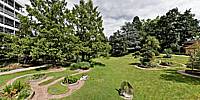
Kingdom – Phylum – Class – Order – FAMILY – Tribe – Genus – Section – Species
Phylogenetic Tree of the Flowering Plants, Botanical Garden, University of Freiburg, Germany
June 24, 2011, 16:25 CEST
© 2011 Carsten T. Rees, All Rights Reserved.
Whereas taxonomy focuses on defining and delimiting taxa, the younger science of phylogenetics aims at describing the evolutionary relatedness of groups of organisms. Phylogenetics is well known for its biological “genealogical trees,” properly addressed as “phylogenetic trees.” These trees show how in evolution different groups of organisms have branched and developed from common ancestors thus indicating how these groups are related to each other.
In the University of Freiburg's Botanical Garden you can find a “life size” “Phylogenetic Tree of the Flowering Plants.” A diagram of this tree (taken from a sign in the botanical garden) is depicted in the bottom of the panorama. Each spot in the diagram corresponds directly to a compartment in the garden. Each compartment represents a taxonomical order and it contains plants from several plant-families belonging to that specific order. The branches of the phylogenetic tree are represented in the garden as paved light-red trails.
Each colour in the diagram represents a subclass. The subclasses of the Dicotyledonae are: Orange — Magnoliidae, Light Blue (to the left) — Hamamelidae, Pink (underneath Purple) — Caryophyllidae, Red — Rosidae, Yellow — Dilleniidae, Dark Blue (to the right) — Asteridae.
Purple marks all three subclasses of the Monocotyledonae: Alismatidae, Arecidae and Liliidae.
In the panorama you can see a huge tree with direct sunlight in it. This tree stands in the large orange compartment at the very base of the phylogenetic tree — Magnoliales.
The compartment on the right of the purple sign is the second compartment in the branch of the Monocotyledonae containing Arales (a well known family of which is Araceae — the Arum family) and Arecales (palm trees).
The two Hominidae on the lawn are lying in direct neighbourhood to the compartment Zingiberales. Some families belonging to that Order are ginger, cardamom, turmeric, galangal. So this order is highly essential for the typical Indian cuisine.
Lat: 48° 0' 34" N
Long: 7° 51' 26" E
Elevation: 263 m
Precision is: High. Pinpoints the exact spot.


 Tap or click the zoom icon in the bottom right corner of the picture to switch between in-page and fullscreen view
Tap or click the zoom icon in the bottom right corner of the picture to switch between in-page and fullscreen view